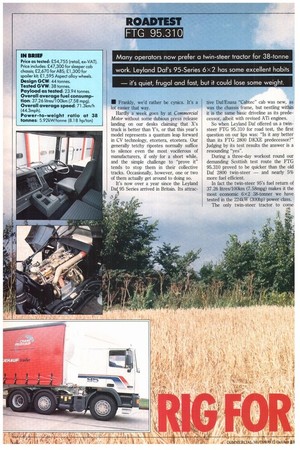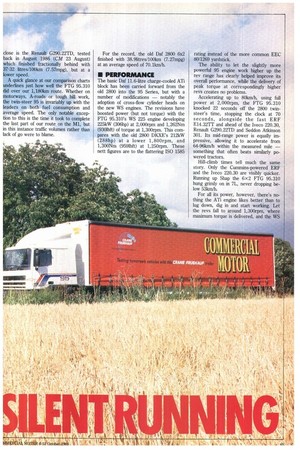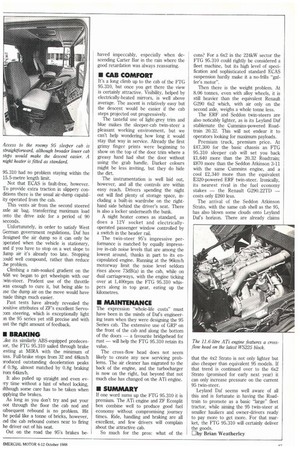Many operators now prefer a twin-steer tractor for 38-tonne work.
Page 46

Page 47

Page 48

Page 49

If you've noticed an error in this article please click here to report it so we can fix it.
Leyland Daf's 95-Series 6x2 has some excellent habits — it's quiet, frugal and fast, but it could lose some weight.
• Frankly, we'd rather be cynics. It's a lot easier that way.
Hardly a week goes by at Commercial Motor without some dubious press release landing on our desks claiming that X's truck is better than Y's, or that this year's model represents a quantum leap forward in CV technology, etcetera, etcetera. Our generally tetchy ripostes normally suffice to silence even the most vociferous of manufacturers, if only for a short while, and the simple challenge to "prove it" tends to stop them in their collective tracks. Occasionally, however, one or two of them actually get around to doing so.
It's now over a year since the Leyland Daf 95 Series arrived in Britain. Its attrac
five Daf/Enasa "Cabtec" cab was new, as was the chassis frame, but nestling within it is the same basic driveline as its predecessor, albeit with revised ATi engines.
So when Leyland Daf offered us a twinsteer FTG 95.310 for road test, the first question on our lips was: "Is it any better than its FTG 2800 DKXE predecessor?" Judging by its test results the answer is a resounding "yes".
During a three-day workout round our demanding Scottish test route the FTG 95.310 proved to be quicker than the old Daf 2800 twin-steer — and nearly 5% more fuel efficient.
In fact the twin-steer 95's fuel return of 37.26 litres/100km (7.58mpg) makes it the most economic 6x2 38-tonner we have tested in the 224kW (300hp) power class.
The only twin-steer tractor to come
close is the Renault G290.22TD, tested back in August 1986 (CM 23 August) which finished fractionally behind with 37-32 litres/100km (7.57mpg), but at a lower speed.
A quick glance at our comparison charts underlines just how well the FTG 95.310 did over our 1,180km route. Whether on motorways, A-roads or tough hill work, the twin-steer 95 is invariably up with the leaders on both fuel consumption and average speed. The only notable exception to this is the time it took to complete the last part of our route on the MI, but in this instance traffic volumes rather than lack of go were to blame. For the record, the old Daf 2800 6x2 finished with 38.91itres/100km (7.27mpg) at an average speed of 70.11(m/h.
• PERFORMANCE
The basic Daf 11.6-litre charge-cooled ATi block has been carried forward from the old 2800 into the 95 Series, but with a number of modifications — notably the adoption of cross-flow cylinder heads on the new WS engines. The revisions have boosted power (but not torque) with the FTG 95.310's WS 225 engine developing 225kW (306hp) at 2,000rpm and I,262Nm (9301bfe of torque at 1,300rpm. This compares with the old 2800 DIO(E's 212kW (288hp) at a lower 1,800rpm, and 1,300Nm (9591bft) at 1,250rpm. These nett figures are to the flattering ISO 1585 rating instead of the more common EEC 80/1269 yardstick.
The ability to let the slightly more powerful 95 engine work higher up the rev range has clearly helped improve its overall performance, while the delivery of peak torque at correspondingly higher revs creates no problems.
Accelerating up to 80km/h, using full power at 2,000rpm, the FTG 95.310 knocked 22 seconds off the 2800 twinsteer's time, stopping the clock at 70 seconds, alongside the fast ERF E14.32TT and ahead of the Iveco 220.30, Renault G290.22TD and Seddon Atkinson 301. Its mid-range power is equally impressive, allowing it to accelerate from 64-96km/h within the measured mile — something that often beats similarly powered tractors.
Hill-climb times tell much the same story. Only the Cummins-powered ERF and the Iveco 220.30 are visibly quicker. Running up Shap the 6x2 FTG 95.310 hung grimly on in 7L, never dropping below 531cm/h.
For all its power, however, there's nothing the ATi engine likes better than to lug down, dig in and start working. Let the revs fall to around 1,300rpm, where maximum torque is delivered, and the WS 225 starts to produce a distinctive grumbling note, holding steady on all but the steepest drags. Approaching the top of a hill, or coming out of a roundabout, it is possible to let the revs fall to around 1,200rpm and still recover comfortably.
• TRANSMISSION
Anyone used to driving a pre-95 Series Daf tractive unit is in for a surprise when climbing up behind the wheel of the FIG 95.310. The familiar 16-speed ZF Ecosplit synchromesh box is still there, but the long gearlever with the distinctive doubleH shift pattern — loved by some, loathed by others — has gone. In its place is a shorter lever with a single-H layout.
To change from low to high range and back again a collar on the lever is raised or lowered. Rotating the collar operates the splitter mechanism.
The switch to the single-H pattern has certainly speeded up gear shifting, giving crisper changes, and has removed the characteristic thwack to the knee delivered by the lever on certain Daf models where the high-range pattern was biased towards 7/8.
Leyland Daf has also responded to criticisms by fitting a dash-mounted warning light to indicate when low split is engaged.
With the adoption of the range-change collar on the 95 series, the long-serving Ecosplit box has also gained a blocker mechanism which prevents low range from being engaged above 30Icrn/h (something that was lacking on the old double-H set-up), thereby preventing engine damage through over-revving.
On the flat the fully-freighted FTG 95.310 pulls away comfortably in 2H, followed by 4L and 5L, with splits thereafter at 1,500rpm. For those in a hurry, however, a 1H/3L/4H/5H sequence followed by splits on every gear does it that little bit quicker. Indeed, the twin-steer 95's engine and gearbox are sufficiently well-matched to allow a variety of tunes to be played on them to suit all conditions.
Adopting the shorter lever hasn't made the shift loads on the ZF Ecosplit box any worse, but they aren't any better either. At times they can be rather high, sending a twinge up the driver's arm as he goes for one of the less willing changes. It is difficult to see how the loads could be reduced without going to a full electropneumatic linkage similar to the Mercedes Powerliners' EPS system. ZF certainly has one — it's called Easy Shift — and Daf is currently evaluating it on the Continent. Whether it will be offered on the 95 Series remains to be seen. In any case, the Ecosplit synchromesh box is simple to use: whichever gear you go for (within reason) you'll get.
• RIDE AND HANDLING
Considering its relatively high cab, the twin-steer 95 shows surprisingly little roll when cornering. Leyland Daf has, sensibly, not totally isolated the driver from what's happening at the wheels and there is enough lateral movement left in the FIG 95.310's four-point coil spring cab suspension to let him know when he is cornering too fast or taking too sharp a line through a roundabout, reminding him to adjust his driving style accordingly.
Two years ago we noted that the twinsteer Daf 2800 "coped noticably better with the exceptional flexing of our tandem-axle trailer, with its bogie mounted at the extreme rear, than do mechanically-suspended twin-steers such as the ERF E-series". For the FTG 95.310, with the same trailer, read ditto.
As might be expected from a three-axle tractor with air-suspension on both the second-steered and drive axles, the 95 twin-steer offers an above-average ride with its electronically controlled air suspension (ECAS) smoothing out all but the very worst road surfaces.
There is, however, more to ECAS than just a good ride. The microprocessorcontrolled system automatically maintains a constant fifth-wheel height, regardless of whether the combination is running laden or empty. It also makes coupling and uncoupling a breeze.
To drop the trailer, hit the raise button on the ECAS handset, mounted to the driver's right (it can also be removed from the cab and operated from the ground via a remote lead) and the air bags are inflated, raising the fifth wheel by some 84mm. Next wind down the landing legs, disconnect everything, and deflate the bags, again via the handset, allowing the chassis to drop away. Then pull forward. There's no fuss, no loud clang as the fifth wheel kicks out from under the trailer (it doesn't even flip up) — just a smooth, gentle getaway.
All that's left to do is press the rideheight reset button, wait a few seconds for the air bags to reinflate to the correct level and you're away. ECAS makes leadup ramps obsolete which, considering the fairly hefty kerbweight of the FTG 95.310, is no bad thing. Also, by being able to control the fifth wheel height, the risk of damaging the front of the trailer when coupling-up is all but eliminated.
On the subject of coupling up, with the trailer kingpin set at 830mm our FTG 95.310 had no problem staying within the 15.5-metre length limit.
Not that ECAS is fault-free, however. To provide extra traction in slippery conditions there is the usual air-dump capability operated from the cab.
This vents air from the second steered axle air bag, transferring maximum load onto the drive axle for a period of 90 seconds.
Unfortunately, in order to satisfy West German government regulations, Daf has designed the air dump so it can only be Dperated when the vehicle is stationary, and if you have to stop on a wet slope to lump air it's already too late. Stopping .-:ould well compound, rather than reduce the problem.
Climbing a rain-soaked gradient on the 468 we began to get wheelspin with our :win-steer. Prudent use of the throttle as enough to cure it, but being able to Ise the dump air on the move would have nade things much easier.
Past tests have already revealed the Dositive attributes of ZF's excellent Servoom steering, which is exceptionally light )ri. the 95 series yet still precise and with ust the right amount of feedback.
I BRAKING
its similarly ABS-equipped predecesmr, the FTG 95.310 sailed through brake .esting at MIRA with the minimum of .uss. Full-brake stops from 32 and 48km/h )roduced outstanding deceleration peaks A 0.9g, almost matched by 0.8g braking rom 64Iun/h.
It also pulled up straight and even evTy time without a hint of wheel locking, dthough some care has to be taken when ipplying the brakes.
As long as you don't try and put your oot through the floor the cab nod and ubsequent rebound is no problem. Hit he pedal like a tonne of bricks, however, Lnd the cab rebound comes near to firing he driver out of his seat.
Out on the road the 95's brakes be hayed impeccably, especially when descending Carter Bar in the rain where the good retardation was always reassuring.
• CAB COMFORT
It's a long climb up to the cab of the FTG 95.310, but once you get there the view is certainly attractive. Visibility, helped by electrically-heated mirrors, is well above average. The ascent is relatively easy but the descent would be easier if the cab steps projected out progressively.
The tasteful use of fight-grey trim and blue makes the sleeper-cab twin-steer a pleasant working environment, but we can't help wondering how long it would stay that way in service. Already the first grimy finger prints were beginning to show on the top of the door trim where a greasy hand had shut the door without using the grab handle. Darker colours might be less inviting, but they do hide the dirt.
The instrumentation is well laid out, however, and all the controls are within easy reach. Drivers spending the night out will find plenty of storage space, including a built-in wardrobe on the righthand side behind the driver's seat. There is also a locker underneath the bunk.
A night heater comes as standard, as does a 12V socket and electricallyoperated passenger window controlled by a switch in the header rail.
The twin-steer 95's impressive performance is matched by equally impressive in-cab noise levels that are among the lowest around, thanks in part to its encapsulated engine. Running at the 96Iun/h motorway limit the noise level seldom rises above 73dB(a) in the cab, while on dual carriageways, with the engine ticking over at 1,400rpm the FTG 95.310 whispers along in top gear, eating up the kilometres.
• MAINTENANCE
The expression "whole-life costs" must have been in the minds of Dots engineering team when they were designing the 95 Series cab. The extensive use of GRP on the front of the cab and along the bottom of the doors — a favourite bridgehead for rust — will help the FTG 95.310 retain its value.
The cross-flow head does not seem likely to create any new servicing problems. The air cleaner has migrated to the back of the engine, and the turbocharger is now on the right, but beyond that not much else has changed on the ATi engine.
• SUMMARY
If one word sums up the FTG 95.310 it is premium. The ATi engine and ZF Ecosplit box combine well to produce good fuel economy without compromising journey times. Ride, handling and braking are all excellent, and few drivers will complain about the attractive cab.
So much for the pros: what of the cons? For a 6x2 in the 224kW sector the FIG 95.310 could rightly be considered a fleet machine, but its high level of specification and sophisticated standard ECAS suspension hardly make it a no-frills "gaffer's motor".
Then there is the weight problem. At 8.06 tonnes, even with alloy wheels, it is still heavier than the equivalent Renault G290 6x2 which, with air only on the second axle, weighs a whole tonne less.
The ERF and Seddon twin-steers are also noticably lighter, as is its Leyland Daf stablemate the Cummins-powered Roadtrain 20.32. This will not endear it to operators looking for maximum payloads.
Premium truck, premium price. At £47,300 for the basic chassis an FTG 95.310 sleeper cab will set you back 21,640 more than the 20.32 Roadtrain; £870 more than the Seddon Atkinson 3-11 with the same Cummins engine, and a cool 22,340 more than the equivalent E320-powered ERF twin-steer. Ironically, its nearest rival in the fuel economy stakes — the Renault G290.22TD — costs only 2260 less.
The arrival of the Seddon Atkinson Strato, with the same cab shell as the 95, has also blown some clouds onto Leyland Dais horizon. There are already claims that the 4x2 Strato is not only lighter but also cheaper than equivalent 95 models. If that trend is continued over to the 6x2 Strato (promised for early next year) it can only increase pressure on the current 95 twin-steer.
Leyland Daf seems well aware of all this and is fortunate in having the Roadtrain to promote as a basic "large" fleet tractor, while aiming the 95 twin-steer at smaller hauliers and owner-drivers ready to pay more to get more. For that market, the FTG 95.310 will certainly deliver the goods. Eby Brian Weatherley






















































